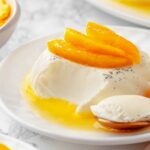italian panna cotta
A rich, creamy Italian panna cotta recipe flavored with vanilla extract and vanilla bean! A pastry chef’s perfect ratio of gelatin to dairy for a soft, melt-in-your-mouth-texture plus an easy peach sauce!
Servings: 6
Ingredients
For the panna cotta:
- 4 teaspoons powdered unflavored gelatin or 2 ¾ silver gelatin sheets
- 6 tablespoons cold water only if using powdered gelatin
- ⅓ cup whole milk 86g
- ½ cup heavy cream 130g
- ½ vanilla bean split & scraped
- pinch kosher salt
- ¼ cup granulated sugar
- ¾ teaspoon vanilla extract
- 1 ½ cups heavy cream
For the macerated peaches
- 1 cup peaches pealed, sliced
- ¼ cup granulated sugar
- 1 lemon zested
- 1-2 tablespoons lemon juice to taste
Instructions
To make the panna cotta:
- Place 6 molds or ramekins on a rimmed baking sheet. Spray lightly with nonstick cooking spray.
Bloom the gelatin:
- If using sheet gelatin, place individual sheets into ice water and allow to soften. This will take 5 minutes. Remove gelatin sheets and squeeze out excess water. Place in a dish to the side until ready to use, but don’t do this step more than 10 minutes in advance or the sheets will begin drying out. Rather, store them in the ice water.
- If using powdered gelatin: In a small bowl whisk together the gelatin and cold water. Allow to sit undisturbed for 5 minutes.
- In a small pot bring ½ cup heavy cream, milk, vanilla bean seeds, salt and sugar just to a boil, stirring frequently to dissolve the sugars.
- Remove the pot with the boiling cream mixture from the heat, and add the bloomed gelatin. Stir to dissolve the gelatin.
- In a separate bowl or blender, combine the remaining cold cream and vanilla. Pour the gelatin mixture into the cold ingredients and either briefly blend in blender or use a hand blender to incorporate. You can also use a whisk rather than a blender if using powdered gelatin.
- Divide between lightly sprayed molds. Cover with plastic wrap and chill completely. 2 hours is the minimum but sometimes they still will not unmold. I like to ride the line between using just enough and not enough gelatin. This produces a panna cotta with perfect mouth feel. It should melt in the mouth rather than feel like Jello. To that effect, I chill overnight always.
- To unmold, place desired serving plate or bowl upside down over the mold. Shake to loosen the panna cotta from the mold and it should fall on the plate. In the Italian restaurant where I served this (and a bunch of other varieties), we briefly ran the outside of the mold under hot water (or dip in a bowl of hot water), over turn and shake it into your hand, then gently place on the plate or bowl for serving. I prefer the look of fluted metal molds but ramekins also work.
Macerated peaches:
- Several hours before serving, combine peaches, sugar, zest and lemon juice in a bowl. Stir to distribute the sugar. Taste and adjust sweetness or lemon juice as needed.
- Cover and refrigerate at least 2 hours or even the day before. You can also gently poach the peaches as well and then refrigerate before serving.
Notes
Yield – 6 servings
Presentation – Serve simply with fresh fruit, macerated berries or granola and toasted nuts.
Storage – Store panna cotta in the refrigerator for up to 7 days or frozen for 2 months. I do recommend storing them covered and unmolding immediately before serving. If frozen, allow 2 hours to thaw in the fridge after unmolding.
Nutrition
Calories: 365kcal | Carbohydrates: 22g | Protein: 5g | Fat: 29g | Saturated Fat: 19g | Polyunsaturated Fat: 1g | Monounsaturated Fat: 7g | Cholesterol: 91mg | Sodium: 35mg | Potassium: 131mg | Fiber: 0.4g | Sugar: 22g | Vitamin A: 1272IU | Vitamin C: 2mg | Calcium: 72mg | Iron: 0.2mg
